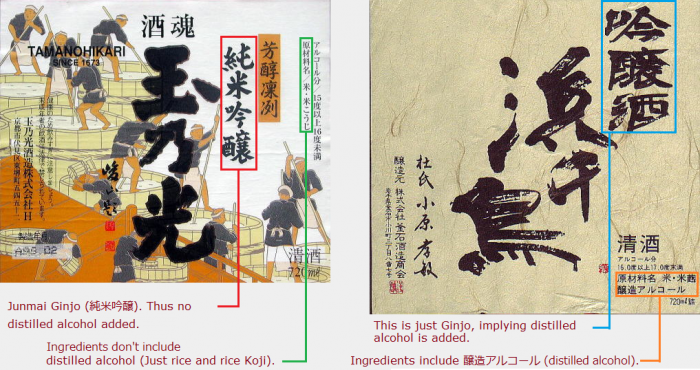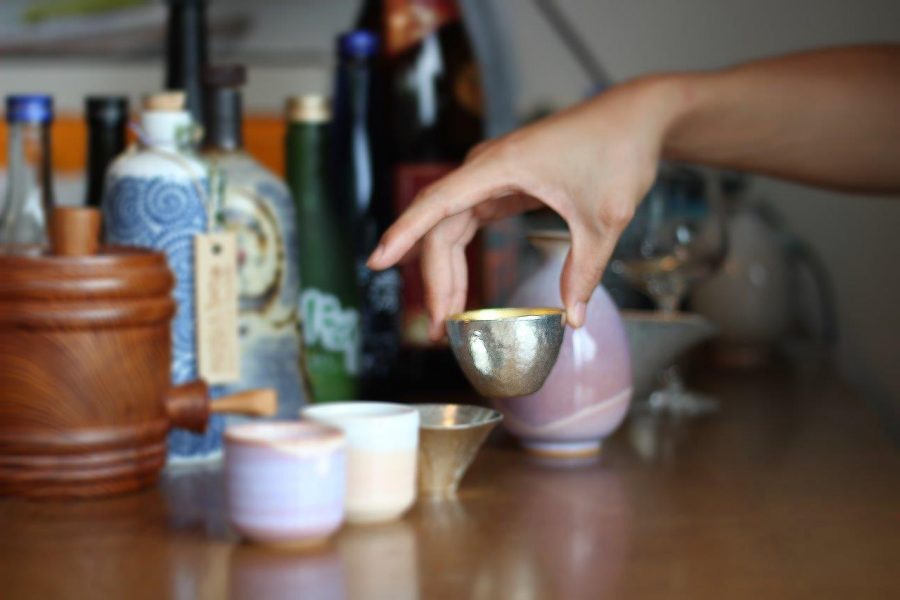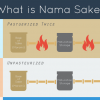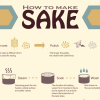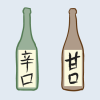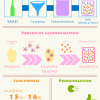Contents
There are many types of Sake. Learning those types of Sake will let you guess the Sake taste and determine its ideal serving temperature. The 8 basic types of Sake are called premium Sake, or Tokutei Meisho Shu in Japanese.
Yes, 8 types. Too many? Don’t worry. Let us make it super simple. In short, types of Sake are categorized by Rice Polishing Ratio and whether distilled alcohol is added. Let’s have a look at our infographic on basic types of Sake!
2 Easy Steps to Basic Types of Sake
Following the infographic above will give you the basic idea of basic types of Sake. Here, we will go into more details:
1. How Much Is Rice Polished?
 The more rice is polished, the cleaner the Sake taste tends to become. The less, the more savory (and more rice-like flavor and off-flavors).
The more rice is polished, the cleaner the Sake taste tends to become. The less, the more savory (and more rice-like flavor and off-flavors).
Sake is first categorized by how much rice is polished. Rice Polishing Ratio (Seimai Buai / 精米歩合 in Japanese) refers to how much of a rice grain remains after polishing. Rice Polishing Ratio of 60% means 60% of an original rice grain remains.
To summarize:
- Less than 50%: Daiginjo, Junmai Daiginjo
- Less than 60%: Ginjo, Junmai Daiginjo, Tokubetsu Junmai, Tokubetsu Honjozo
- Less than 70%: Honjozo
- Unspecified: Junmai
2. Is Distilled Alcohol Added?
Distilled alcohol may be added to adjust Sake flavors (give cleaner flavor).
Sake without distilled alcohol has a prefix of ‘Junmai (純米)’ before its name. Junmai literally means ‘pure rice’ in Japanese. Distilled alcohol is called ‘Jozo aruko-ru (醸造アルコール)’.
To summarize:
1. Distilled alcohol NOT added:
Junmai Shu (純米酒), Junmai Ginjo (純米吟醸), Junmai Daiginjo (純米大吟醸), Tokubetsu Junmai (特別純米).
Tends to have rich, savory, grainy, rice-like taste.
2. Distilled alcohol added:
Ginjo (吟醸), Daiginjo (大吟醸), Honjozo (本醸造), Tokubetsu Honjozo (特別本醸造).
Tends to have cleaner taste.
Please note that adding distilled alcohol is not necessarily bad. Many award-winning Sake have distilled alcohol in it.
3 Types of Aroma and Flavor
These 8 types of Sake can be roughly categorized into 3 types of aroma and flavor:
1. Ginjo Type: Light Body and Fragrant Aroma
Include: Daiginjo, Junmai Daiginjo, Ginjo and Junmai Ginjo.
Main characteristic: light-body, clean, fragrant and fruity. Its fruity aroma of apple and banana is peculiar to Ginjo type and attributable to low temperature fermentation.
Recommended serving temperature: Cold. Explore more about Best Sake Serving Temperature.
Ginjo type is often called premium Sake as it tends to be more expensive than other types of Sake. Why expensive? Because rice polishing ratio is very low (i.e. less supply) and it requires more hard, sensitive and skilled work.
2. Honjozo Type: Light Body and Subtle Aroma
Include: Honjozo Sake and Tokubetsu Honjozo.
Distilled alcohol is added to give cleaner Sake taste.
Recommended serving temperature: Hot and cold.
3. Junmai Type: Full Body and Subtle Aroma
Includes: Junmai Sake (and Tokubetsu Junmai).
Main characteristic: Rich, savory, full-body, subtle aroma. Despite subtle aroma, Junmai type tends to have rice-like, grainy flavor and aroma; the true taste of Sake can be enjoyed.
Recommended serving temperature: Hot and room temperature. Savory, rice-like aroma opens up when served hot. The original taste of Sake can be best enjoyed at room temperature (my favorite way!).
As explained above, Junmai type has not distilled alcohol in it.
Pitfalls of Types of Sake
There are a couple of pitfalls (or rather, complexities) when learning basic types of Sake.
1. Tokubetsu Junmai and Tokubetsu Honjozo
Tokubetsu Junmai and Tokubetsu Honjozo have rice polishing ratio of less than 60% – same as Ginjo and Junmai Ginjo. But their characteristics greatly differ from the aromatic Ginjo type.
The characteristics of Tokubetsu Junmai can be somewhere between Honjozo and Junmai type. ‘Tokubetsu’ literally means ‘special’. As these Tokubetsu types declare themselves to be ‘special,’ how they are special (in Sake making method) must be explained on bottle labels.
2. No fixed Aroma and Flavor
Those 8 types of Sake have their typical aroma and flavor (as described above). But they are just TYPICAL. For example, some Ginjo Sake do not have Ginjo type’s typical fruity aroma, while some Junmai Sake are not as savory as typical Junmai type is.
This is why you can’t be 100% sure about Sake taste by just decoding the bottle label. It is the complicated part of Sake as well as beauty of Sake. Maybe similar to wine in this way?
Each Sake has its own uniqueness. You can roughly guess it by reading the Sake label, but can be 100% sure only after giving it a try.
Other Types of Sake?
Of course, types of Sake are not only those 8. Other types of Sake include Nama Sake, Genshu, Nigori Sake, etc. to name a few.
We will soon upload an article on those other types of Sake. Follow our SNS pages for updates!


